

Changing the Direction of SAP, ERP, and IT Applications to Focus on the Customer and Innovation. This is the third part of an ongoing series on where the application technology market is today, including ERP vendors like SAP, Oracle, and others–, and where the market is headed.
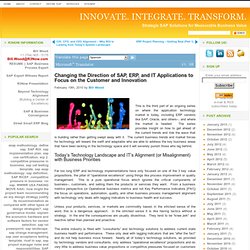
The series provides insight on how to get ahead of the current trends and ride the wave that is building rather than getting swept away with it. The current business trends and market forces for technology will reward the swift and adaptable who are able to address the key business areas that have been lacking in the technology space and it will severely punish those who lag behind.
Today’s Technology Landscape and IT’s Alignment (or Misalignment) with Business Priorities Far too long ERP and technology implementations have only focused on one of the 3 key value propositions, the pillar of “operational excellence” using things like process improvement or quality management. Unless your products, services, or markets are commodity based, in the strictest sense of the word, this is a dangerous approach.
CIO, CFO, and CEO Alignment - Why ROI is Lacking from Today's System Landscape. The first part of this series looked at What is the Proper Relationship for the CIO, CEO, and CFO?

The CIO role is already challenging and gaining in difficulty in today’s business environment. And by all measures it looks as though things will continue to become more difficult and complex as time goes on. Today’s CIO must not only keep up with technology, and business process improvement with automation, but must also become a “mini-MBA” in applying technology solutions to forward looking business strategies including customer acquisition, customer retention, revenue growth and profitability.
Where Do You Find the Business Benefit? Retool, retool quickly!
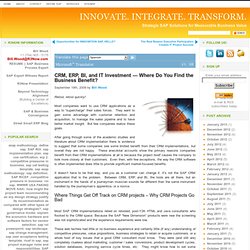
Most companies want to use CRM applications as a way to “supercharge” their sales forces. They want to gain some advantage with customer retention and acquisition, to manage the sales pipeline and to have better market insight. But few companies realize these goals. After going through some of the academic studies and literature about CRM implementation there is evidence to suggest that some companies see some limited benefit from their CRM implementations, but overall they are not happy.
These anecdotal accounts show the primary reasons companies benefit from their CRM implementations at all is because the project itself causes the company to look more closely at their customers. It doesn’t have to be that way, and you as a customer can change it. Where Things Get Off Track on CRM projects – Why CRM Projects Go Bad. Business and IT Alignment - Integrating Technology and IT Spend with Business. Traditional business schools teach two key concepts around business (once you have settled on a product or service) and those are value propositions and competitive pressures.IT (Information Technology) has NOT integrated with business well EXCEPT in the commodity markets.

The universally zealous focus on process improvements, process automation, and business process management only addresses ONE of the three value propositions. And that type of a focus ends up creating commodities of the product or service (if it is not already a commodity).IT has only aggressively addressed the “operational excellence” pillar of business. They are only now BEGINNING to seriously look at customer focus and innovation is just barely a blip on the radar screen.None of this even addresses the competitive pressure landscape either. A New SAP Implementation Methodology and Implementation Steps. SAP Project Dimensions Studies have shown that there is a critical disconnect between projected benefits in business cases for IT investments and actual value achieved, because so many firms focus on going live with a project rather than its value delivery.
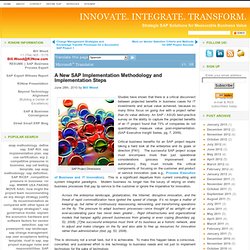
An SAP / ASUG best-practice survey on the ability to capture the projected benefits of an IT project found that 73% of companies do not quantitatively measure value post-implementation. (SAP Executive Insight Series, pg. 7, 2009). Achieving Business Value from SAP Investment. SAP Business Value & ROI As a follow up to last week’s post on Sustained Business Value from SAP Business Software I did a little research on the study authors and discovered their continued focus on this issue.
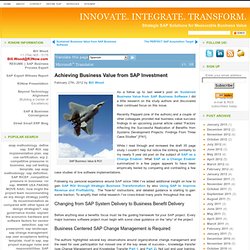
Recently Peppard (one of the authors) and a couple of other colleagues provided real business value success findings in an upcoming journal article called “Factors Affecting the Successful Realization of Benefits from Systems Development Projects: Findings From Three Case Studies” [FN1]. While I read through and reviewed the draft 35 page study I couldn’t help but notice the striking similarity to my nearly 5 year old post on the subject of SAP as a Change Enabler. What SAP as a Change Enabler summarized in a few pages appears to have been empirically tested by comparing and contrasting a few case studies of live software implementations. Sustained Business Value from SAP Business Software.
SAP Benefit and ROI From time to time I review academic literature about the application of technology and offer my SAP experience based perspective.
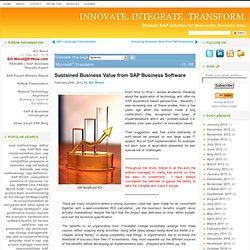
Recently I was reviewing one of these studies from a few years ago when the authors made a key clarification: they recognized two types of implementations which are problem-based (i.e. address your “pain points”) or innovation based. Their suggestion was that some elements of both would be present on any large scale IT project, like an SAP implementation for example, but each type of application presented its own special set of challenges. Throughout the study (linked to at the end) the authors managed to clarify key points so they are easy to understand. I have always considered the hallmark of genius the ability to take the complex and make it simple. They warn against one of the most common hidden pitfalls of Enterprise Software (ES) like SAP turning into a technology project rather than a change lever for advancing corporate strategy.
Why Indexed KPIs are Critical for Business Performance and Success. As I’ve written before not every metric for business or processes is a KPI.
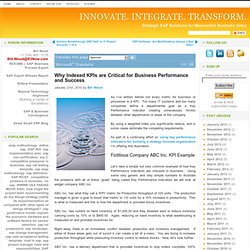
Too many IT systems and too many companies define a departmental goal as a Key Performance Indicator creating unnecessary friction between other departments or areas of the company. By using a weighted index you significantly reduce, and in some cases eliminate the competing requirements. As part of a continuing effort on using key performance indicators for building a strategy focused organization I’m offering this illustration. Fictitious Company ABC Inc. KPI Example. Using SAP to Improve Revenue and Profitability.
For years CIOs have been under pressure to help cut costs, improve operational efficiencies, and automate the enterprise; CIOs implementing SAP have largely been effective at streamlining the back-office.
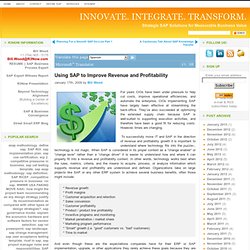
They’ve also succeeded at optimizing the extended supply chain because SAP is well-suited to supporting execution activities, and therefore have been a good fit for reducing costs. However, times are changing. Why SAP Projects Fail to Deliver ROI and How to Change IT. Part of the frustration with the failure of results in SAP implementations is the “hangover” from the Y2K effect.
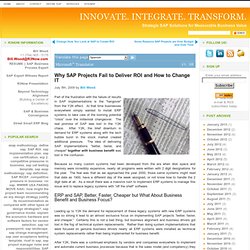
At that time businesses everywhere simply wanted to install ERP systems to take care of the looming potential “crisis” over the millennial changeover. The real promise of SAP was lost in the Y2K chaos. After Y2K, the brief downturn in demand for ERP systems along with the tech bubble burst in the stock market created additional pressure. The idea of delivering SAP implementations “better, faster, and cheaper” together with business benefit was lost in the confusion. Because so many custom systems had been developed from the era when disk space and memory were incredibly expensive, nearly all programs were written with 2 digit designations for the year.
Change How You Look at SAP to Create ROI. I’ve learned many lessons over the years after participating in many ROI focused projects–, a few of them achieved great results, but unfortunately many more were mediocre. Tactics, Strategy, ROI, TCO and Realizing Business Benefit from SAP. When implementing or upgrading SAP too often I encounter back yard mechanics who changed the oil on someone’s cars and checked the tire pressure–, somehow they think that qualifies them to do engine overhauls on Formula 1 race cars.
And just in case the analogy doesn’t seem to make sense, why again do you expect old-style implementation vendors and consultants to transform your business into a competitive powerhouse by only addressing cost-focused ROI and TCO methods? What About SAP and ERP Cost Savings for ROI and TCO? Sure, cost-savings and process improvements are critical today, and they can not be ignored or dismissed on any ERP project, but they can NOT be the key focus of the project either if you expect your company to gain any marketplace competitive advantage. No wonder survey after survey shows C-level executives disappointed by the return on their ERP investments.
Using Key Performance Indicators for Building a Strategy Focused Organization. Key Performance Indicator The key performance indicator acronym (KPI) is used so much that it has come to be associated with any type of business measure. Everything is called a KPI and it is a silly distraction from an important business tool.
Not every measure is a KEY Performance Indicator, only those measures that are critically important to making a difference in the marketplace are truly KEY to your company health and performance. Because of this confusion around Key performance indicators the wrong measurements are often used. ERP and SAP Business Case for ROI, Business Benefit, and Success. SAP Business Case Target Your company’s SAP or ERP business case should start before your RFP, and not just at a high level. It is important to take some time up front to get educated and develop some key understanding before ever issuing an SAP RFP.
There are a number of steps you can and should take, first among them is to get educated. Educated software buyers are more sophisticated, and the more sophisticated you are the better your results will be. There are many benefits to being an educated software buyer. The better the quality of the ERP RFI or RFP.The better choice you will make at vendor selection (you’ll be able to see past sales pitches to the substance).You’ll be able to make a more objective assessment during demonstrations.You’ll be able to focus on ensuring vendors show you what is really important to make a better decision.The better your project will be scoped and blueprinted, and; Ultimately, you will end up with a better project and results overall.